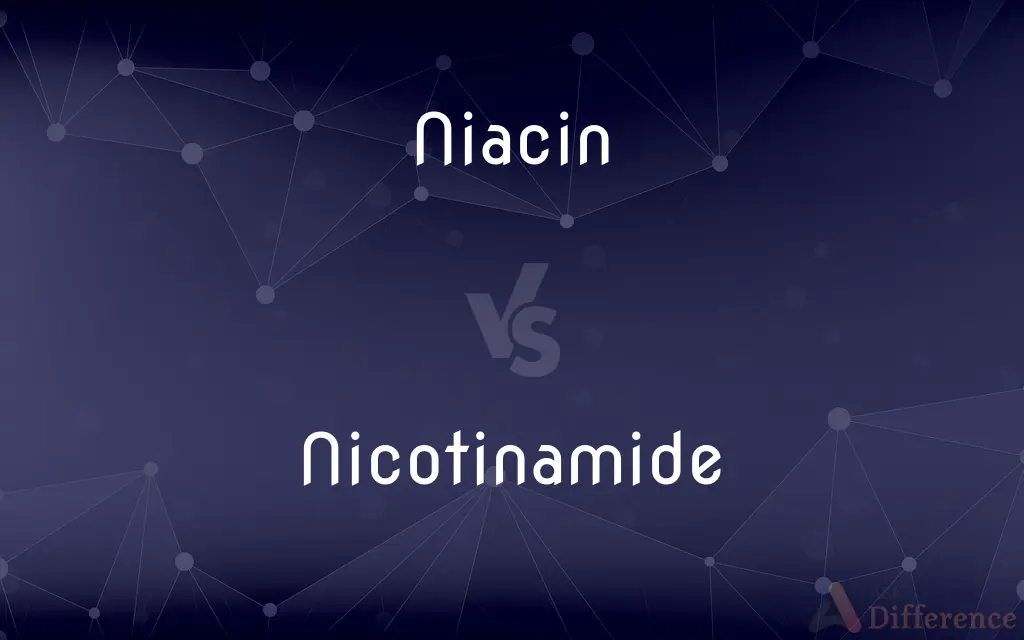Niacin vs. Nicotinamide — What's the Difference?
By Urooj Arif & Maham Liaqat — Updated on May 8, 2024
Niacin (Vitamin B3) and nicotinamide are both forms of Vitamin B3. Niacin can cause skin flushing, while nicotinamide does not. Both are used to treat niacin deficiency, but nicotinamide is often preferred in skincare and medical contexts.

Difference Between Niacin and Nicotinamide
Table of Contents
ADVERTISEMENT
Key Differences
Niacin is an essential nutrient known as Vitamin B3, crucial for metabolic functions. It often leads to "niacin flush," a reddening of the skin. Nicotinamide, also known as niacinamide, is another form of Vitamin B3 that lacks this flushing effect.
Niacin plays a vital role in converting food into energy and synthesizing coenzymes. In contrast, nicotinamide is known for its anti-inflammatory properties, making it popular in dermatology.
Niacin can be used to treat high cholesterol and niacin deficiency. On the other hand, nicotinamide is often recommended in dietary supplements and skincare products due to its gentler nature and antioxidant benefits.
Niacin is less frequently used in cosmetics because of its flushing side effect. Meanwhile, nicotinamide is often incorporated into creams and serums to reduce acne and hyperpigmentation.
In higher doses, niacin may cause more side effects, like liver toxicity. Nicotinamide is better tolerated in larger doses and is commonly used in clinical settings.
ADVERTISEMENT
Comparison Chart
Definition
Vitamin B3 with flushing effect
Vitamin B3 without flushing
Primary Use
Treats cholesterol and deficiency
Skin health, supplements
Skin Flushing
Can cause "niacin flush"
No flushing effect
Dermatology Application
Limited due to flushing
Reduces acne, inflammation
Side Effects
Possible liver toxicity in high doses
Generally well-tolerated
Compare with Definitions
Niacin
A vitamin used to prevent or treat pellagra.
Niacin deficiency can lead to a condition called pellagra.
Nicotinamide
A form of Vitamin B3 with no flushing effects.
Nicotinamide was chosen because it's easier to tolerate.
Niacin
A form of Vitamin B3 used to treat cholesterol.
The doctor prescribed niacin to help lower the patient's cholesterol.
Nicotinamide
A popular skincare ingredient for reducing acne.
The dermatologist recommended nicotinamide to treat breakouts.
Niacin
An essential nutrient for energy metabolism.
Niacin is vital for converting carbohydrates into energy.
Nicotinamide
An anti-inflammatory supplement.
Nicotinamide helps with skin inflammation due to its antioxidant properties.
Niacin
A nutrient naturally found in meat, fish, and grains.
Foods like chicken and tuna are good sources of niacin.
Nicotinamide
A treatment for niacin deficiency.
Nicotinamide supplements are effective in preventing pellagra.
Niacin
A supplement that may cause skin flushing.
Niacin supplements often cause a noticeable flushing reaction.
Nicotinamide
A vitamin included in multivitamins.
Nicotinamide is found in most B-complex multivitamins.
Niacin
Niacin, also known as nicotinic acid, is an organic compound and a form of vitamin B3, an essential human nutrient. It can be manufactured by plants and animals from the amino acid tryptophan.
Nicotinamide
Niacinamide or nicotinamide (NAM) is a form of vitamin B3 found in food and used as a dietary supplement and medication. As a supplement, it is used by mouth to prevent and treat pellagra (niacin deficiency).
Niacin
A white crystalline acid, C6H5NO2, of the vitamin B complex that is found in meat, fish, legumes, and whole-grain foods and is used to treat and prevent pellagra. Also called nicotinic acid.
Nicotinamide
The amide of nicotinic acid (or niacin).
Niacin
(vitamin) A water-soluble vitamin, a component of vitamin B complex, found in meat, yeast, and dairy products; it is essential to metabolism.
Niacin
A B vitamin (vitamin B5) essential for the normal function of the nervous system and the gastrointestinal tract. Called also nicotinic acid and antipellagra vitamin. Chemical formula C6H5NO2, chemically it is 3-pyridinecarboxylic acid.
Niacin
A B vitamin essential for the normal function of the nervous system and the gastrointestinal tract
Common Curiosities
Can both niacin and nicotinamide be used to prevent pellagra?
Yes, both are effective for preventing and treating niacin deficiency.
Does nicotinamide improve energy levels like niacin?
Both support energy metabolism, but niacin is more potent for this purpose.
Which form is better for skincare?
Nicotinamide is preferred for skincare due to its anti-inflammatory properties and lack of flushing.
Is nicotinamide safe in higher doses?
Generally, yes. Nicotinamide is well-tolerated even in larger doses.
Do niacin and nicotinamide occur naturally in foods?
Yes, both are found in meats, fish, grains, and vegetables.
Does niacin affect mood or mental health?
Some research suggests niacin may help with certain mood disorders, but more studies are needed.
Does nicotinamide treat high cholesterol like niacin?
No, niacin is more effective for cholesterol management.
Can niacin be taken daily without side effects?
In lower doses, niacin is safe, but higher doses can lead to liver toxicity and flushing.
Does niacin cause liver damage?
High doses of niacin can lead to liver toxicity, so it's used cautiously.
Are niacin and nicotinamide the same thing?
Both are forms of Vitamin B3, but niacin can cause flushing while nicotinamide doesn't.
Can I take both niacin and nicotinamide supplements?
Generally, it's unnecessary since they both provide Vitamin B3, but a healthcare provider can offer advice.
Is nicotinamide used to treat cholesterol?
No, it doesn't have the same cholesterol-lowering effects as niacin.
Is nicotinamide suitable for vegetarians?
Yes, nicotinamide supplements are usually vegetarian-friendly.
Is nicotinamide suitable for sensitive skin?
Yes, nicotinamide is often recommended for sensitive or acne-prone skin.
Is nicotinamide effective for reducing wrinkles?
It may help improve skin texture and reduce fine lines due to its anti-aging properties.
Share Your Discovery

Previous Comparison
Proviso vs. Provision
Next Comparison
Miner vs. MinorAuthor Spotlight
Written by
Urooj ArifUrooj is a skilled content writer at Ask Difference, known for her exceptional ability to simplify complex topics into engaging and informative content. With a passion for research and a flair for clear, concise writing, she consistently delivers articles that resonate with our diverse audience.
Co-written by
Maham Liaqat















































